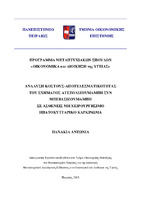Ανάλυση κόστους-αποτελεσματικότητας του σχήματος ατεζολιζουμάμπη συν μπεβασιζουμάμπη σε ασθενείς με μη χειρουργήσιμο ηπατοκυτταρικό καρκίνωμα
Cost-effectiveness analysis of atezolizumab plus bevacizumab in patients with unresectable hepatocellular carcinoma

View/
Keywords
Ηπατοκυτταρικό καρκίνωμα ; Οικονομική αξιολόγηση ; Ανάλυση κόστους-αποτελεσματικότητας ; Ατεζολιζουμάμπη ; Μπεβασιζουμάμπη ; Σοραφενίμπη ; Partitioned Survival Model (PSM) ; ICER ; Hepatocellular carcinoma ; Economic evaluation ; Cost-effectiveness analysis ; Atezolizumab ; Bevacizumab ; SorafenibAbstract
In 2023, liver cancer was the sixth most common cancer and the third leading cause of cancer-related death worldwide, with projections up to 2050 indicating rising incidence and mortality. Hepatocellular carcinoma is a primary liver malignancy, accounting for approximately 90% of primary liver cancers, and develops in over 80% of instances on cirrhotic liver, primarily due to HBV, HCV, or NASH. Its incidence increases with age, peaking around 70 years, and Southern European countries, such as Greece, report intermediate incidence levels.
Findings from the clinical trial IMbrave150 showed that overall survival and progression-free survival in patients with unresectable hepatocellular carcinoma who had not received prior systemic therapy, were significantly improved with atezolizumab plus bevacizumab compared to sorafenib. This regimen was approved by the European Medicines Agency in 2020 for patients with advanced, unresectable HCC who had not previously received systemic therapy.
Atezolizumab is a monoclonal antibody that binds to PD-L1 protein, enhancing the immune system’s ability to target cancer cells. Bevacizumab is a monoclonal antibody against vascular endothelial growth factor (VEGF), inhibiting angiogenesis and limiting tumor growth.
Objective: This dissertation aims to evaluate the cost-effectiveness of atezolizumab plus bevacizumab in patients with unresectable hepatocellular carcinoma who haven’t received prior systemic therapy from the perspective of the Greek National Health System. The analysis compared atezolizumab plus bevacizumab to sorafenib over the patients’ lifetime horizon.
Methods: A partitioned survival model with three health states, “progression-free survival (PFS)”, “progressed disease (PD)”, and “death” was developed for the cost-effectiveness analysis. Effectiveness was estimated based on Kaplan-Meier curves originating from the IMbrave150 clinical trial, while costs and other model inputs were sourced from the worldwide and the Greek literature. Patients were followed in monthly cycles over 72 months, reflecting life expectancy. A 3.5% annual discount rate was applied. Sensitivity analysis was conducted to evaluate the robustness of the results against model uncertainties.
Results: Treatment with atezolizumab plus bevacizumab is associated with higher per-patient costs but provides more quality-adjusted life years (QALYs) compared to first-line treatment with sorafenib for unresectable hepatocellular carcinoma. The incremental cost-effectiveness ratio (ICER) was estimated at 20,043.30 € per QALY gained over the patients’ lifetime. Sensitivity analysis confirmed the robustness of the analysis, highlighting that ICER is particularly sensitive to changes in the prices of atezolizumab and bevacizumab.
Conclusions: The analysis indicates that atezolizumab plus bevacizumab as first-line therapy, compared to sorafenib, is a cost-effective option for patients with unresectable hepatocellular carcinoma according to the current World Health Organization guidelines for Greece.


